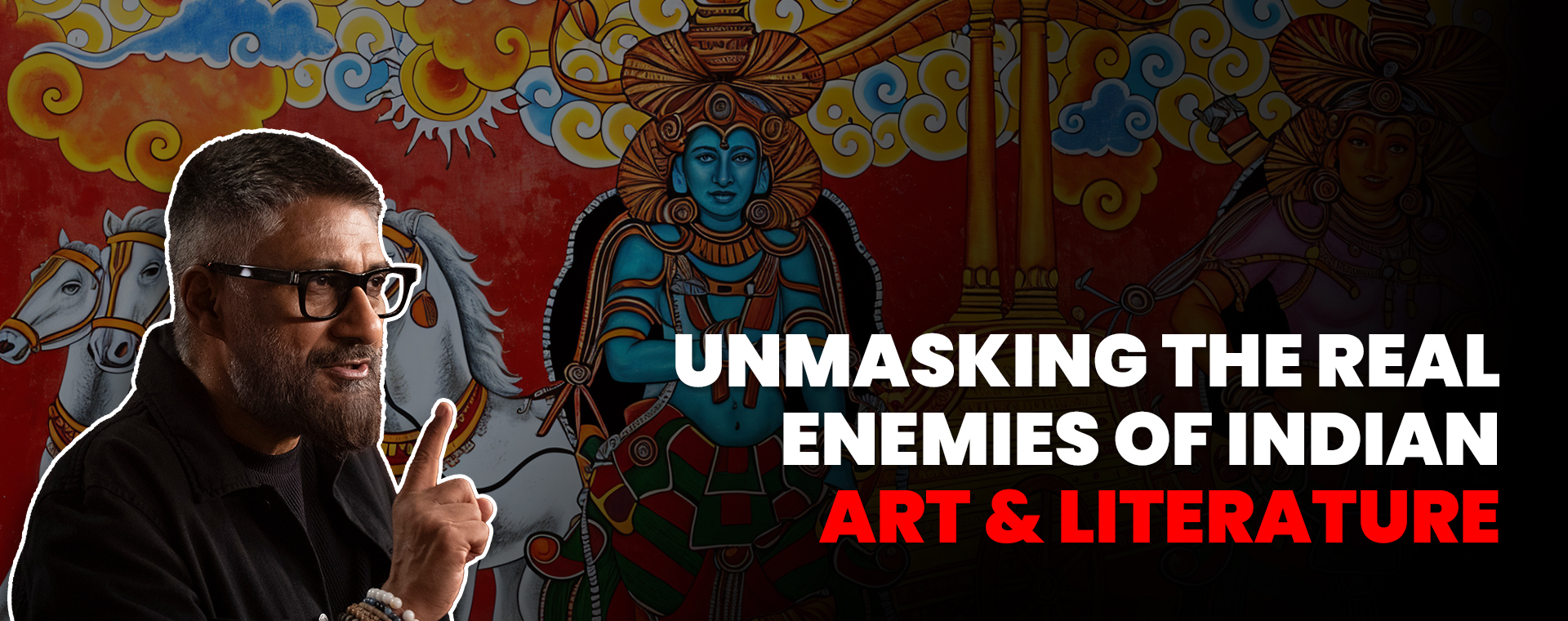

Who’s Destroying India’s Cultural Soul?
Let’s investigate the threats to Indian art and literature through an insightful discussion between Vivek Agnihotri and Vishal Chaturvedi, highlighting the crucial need for cultural preservation and innovation.
The conversation between Vivek Ranjan Agnihotri and Vishal Chaturvedi in the podcast “Enemies of Indian Art & Literature” shows how Indian art and literature have declined. This blog looks into the critical points discussed, providing an insightful analysis of the issues.
Indian Art & Literature Are Dying
Vivek Agnihotri’s stark declaration, “Art and literature are dying,” serves as a wake-up call to the current state of Indian art and literature. Despite its rich history, the decline is palpable, with significant challenges such as a lack of support and recognition for genuine talent, overshadowed by commercial pressures and the pursuit of instant fame. The crisis is further compounded by the marginalisation of traditional and regional art forms in favour of more commercially viable genres. This urgent situation demands our attention and action.
The Importance of Language
Language plays a crucial role in shaping art and literature. It is not merely a medium of communication but a vehicle for cultural expression and identity. Agnihotri and Chaturvedi expose how the erosion of regional languages favouring English has led to a homogenization of literary expression, stripping away the rich diversity that once characterised Indian literature. The decline of languages like Sanskrit, Tamil, and Bengali diminishes the cultural heritage embedded in these languages, leading to a loss of unique literary voices.
Dharma, Politics, and Literature
Another focal point is the interplay between dharma (moral duty), politics, and literature. Literature has historically been a powerful tool for social and political commentary. However, contemporary Indian literature often shies away from challenging the status quo due to political pressures and the fear of backlash. This self-censorship stifles critical discourse and undermines the role of literature as a catalyst for social change.
The Impact of Cinema
As a dominant cultural force, cinema significantly influences societal values and norms. Agnihotri emphasises that cinema has the potential to elevate societal consciousness, but it often prioritises entertainment over substance. The obsession with box office collections and star power has led to a decline in the quality of content. Films that challenge societal norms or present alternative narratives are often sidelined in favour of formulaic blockbusters.
Content Dictated by Market Forces
The discussion reveals that the content produced in India today is heavily dictated by market forces. Publishers, producers, and media houses prioritise profitability over artistic integrity. This commercial mindset stifles creativity and innovation, creating a homogenised cultural landscape. The push for mass appeal often leads to the dilution of complex themes and the simplification of narratives.
AI, Art, and Literature
The advent of artificial intelligence presents both opportunities and challenges for Indian art and literature. AI can enhance creative processes by providing new tools for artists and writers. However, there is also a risk that AI could further commercialise art and literature, reducing them to algorithmically generated content devoid of human emotion and nuance. The ethical implications of AI in creative fields must be carefully considered to preserve the integrity of artistic expression.
The Importance of Aesthetics
Aesthetics, the philosophy of beauty and taste, is a crucial aspect of art and literature. Agnihotri and Chaturvedi advocate for a balanced approach in contemporary Indian art, one that values both aesthetic appeal and intellectual depth. They argue that art should not be reduced to shock value or political correctness, but should strive to create beautiful and thought-provoking works. This balanced approach inspires hope for the future of Indian art and literature.
Nationalism and Cultural Identity
Nationalism, when interpreted as pride in one’s cultural heritage, can play a positive role in the Indian arts. Agnihotri suggests a renewed focus on Indian cultural and philosophical traditions can inspire a new wave of artistic and literary excellence. However, it’s crucial to remember that nationalism should not be conflated with xenophobia or cultural chauvinism. Instead, it should celebrate India’s diversity and encourage the exploration of its multifaceted identity. This emphasis on diversity ensures that all voices and perspectives are appreciated in the Indian arts.
Bollywood’s Box Office Obsession
Bollywood’s fixation on box office numbers often leads to producing formulaic films, such as repetitive romantic comedies or action movies, that maximise profits rather than push creative boundaries. The industry’s focus on star power over storytelling compromises cinema quality, making it difficult for innovative and meaningful films to find an audience. Similarly, the conversation also critiques the superficiality propagated by social media, where airport looks, which are often celebrity fashion statements, and celebrity lifestyles dominate the discourse.
Stars and Stardom
The culture of stardom in Bollywood perpetuates a hierarchy that marginalises new and unconventional talent. Aspiring artists and filmmakers often need connections or the backing of influential figures to break into the industry. This star-driven system perpetuates a cycle where only a select few control the narrative, leaving little room for diverse voices and perspectives.
Social Media & Airport Looks
The conversation also touches on the superficiality propagated by social media, where airport looks and celebrity lifestyles dominate the discourse. This trend diverts attention from substantive cultural discussions and reinforces a consumerist mindset. Social media’s focus on fleeting trends and viral content undermines the deeper, more meaningful engagement with Indian art and literature.
Conclusion
The conversation between Vivek Ranjan Agnihotri and Vishal Chaturvedi highlights the multifaceted challenges facing Indian art and literature today. These issues require a concerted effort to address, from the commercialization of content to the erosion of language and cultural identity. By fostering a renewed appreciation for aesthetics, embracing technological advancements responsibly, and prioritising substance over profit, there is hope for revitalising India’s rich artistic and literary heritage.






